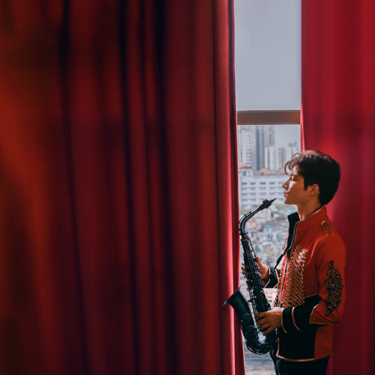What does a dream day in Montreux look like? We asked this question to the journalists who report on the concerts and backstage every summer! Find their stories, real or fantasized, from July 3rd to 18th on our website.
Bloody hell, 20 years! OK, I’m opening with a swear word, that’s one of the good things about age and propriety. But even still, 20 years… Twenty summers in a row, precisely twenty July openings spent at the Montreux Jazz between 2000 and 2019, to be chronicled in the best daily newspaper of French-speaking Switzerland and its environs, never yielding to the call of the beaches and bikinis, remaining on the contrary impassive in front of the stage, night after night, notebook in hand, pass around my neck, ears cleaned with ammoniated Q-Tips to filter each note against the merciless yardstick of my sometimes severe subjectivity, never wrong, not always.
“Isn’t the dream night a mix of these diffuse memories, these images colliding, composing a multicoloured and informal parade of what music has produced in bulk over the last 20 years, from the biggest star to the smallest discovery?”
It took a global pandemic for me to take a holiday in July. While this may seem disproportionate, it is nonetheless upsetting. Fortunately, the proposal to throw out a few words on this 54th festival without a festival has restored a bit of normality to my calendar, even though I’m doing it from a beach between two bikinis. Except that it’s no longer a question of “living” Montreux Jazz, but of imagining it, fantasising about it, of conveying in words what kind of divine pleasure my “dream night” would have been. Like listening to a supergroup with John Frusciante and Jack White on guitar and Greg Dulli on vocals. Or The Cure at the Stravinski. Or a reunion of the Stray Cats or Fugazi. Or an acoustic performance by Martin Gore. Or Bruce Springsteen covering Townes Van Zandt. Or a few tasty morsels to satisfy my appetite for neo-classical rock, punk blues and dirty folk, artists who wouldn’t fill a venue in Montreux by themselves, but never mind – Blitzen Trapper, Kurt Vile, Two Gallants, Ryan Adams, Clutch…
In “The Bridge over the River Kwai”, a moustachioed sergeant, very upstanding, very proud, very British, asks his subordinate if he has ever calculated the sum total of his life’s deeds. It is this officer I am thinking of as the wave licks my left calf. Not because I can imagine him at the microphone with Fu Manchu as backing band (this is a dream concert), but because the absence of Montreux Jazz, rather than projecting me into future daydreams, brings me back to the hundreds of hours I have spent there. Do not see this as an exaggerated pessimism for the future, nor an outrageous backwardness. Simply, contemplating these 20 stored editions, reliving flashes of concerts that I cannot be sure are really the best I experienced because they are the most memorable, I wonder: how do I quantify this sum of music, this combination of sensations – pleasure, ecstasy, surprise, boredom, disappointment – this multitude of moments filed away in one and the same noggin? Isn’t the “dream night” a mix of these diffuse memories, these images colliding, composing a multicoloured and informal parade of what music has produced in bulk over the last 20 years, from the biggest star to the smallest discovery?
“Those same dressing rooms in the Auditorium were where Lemmy, from Motörhead, offered me a whisky, in vain (I don’t drink) and then a ciggy (I don’t smoke) before asking me if I was dynamite in bed.”
The images mingle and, apologies, I know we should leave death at the door, but there emerges a dance step by Prince, so brilliantly slutty that he placed more importance on showing his good side to the camera than on concentrating on the superhuman guitar solo he was playing perched on high heels. Nick Cave, alive and well in 2018, succeeds him, standing in the middle of an audience on their knees, literally and figuratively. Antony’s first appearance, with her Johnsons, comes into view, in a Miles Davis silence. Also, the salt and pepper hair of Adam Yauch, a.k.a. MCA, who I bumped into outside the dressing rooms before two fabulous nights with the Beastie Boys. Those same dressing rooms in the Auditorium were where Lemmy, from Motörhead, offered me a whisky, in vain (I don’t drink) and then a ciggy (I don’t smoke) before asking me if I was dynamite in bed. Thanks baby. Two deaths in a row, sorry again, but 20 years is a long enough time to count a few departed – the festival may be “jazz”, but it’s still rock’n’roll. Like Iggy Pop, for instance, who lost his tooth in 2018 in the middle of the concert.
“As Neil Young sang at the Stravinski in 2001: “Rock’n’roll will never die”. Good festivals neither.”
From one gnasher to another, I see Tom Verlaine, founder of Television and saviour of New York punk, humbly eating in the basement of the Palais des Congrès, at the technicians’ table. For me, it’s not images of glam, swagger and big bucks, galas and rhinestones during my 20 years in Montreux, but moments of real authenticity, like Josh Homme backstage, picking the set list of his concert at the Miles Davis Hall from the four Queens Of The Stone Age albums (we were in 2005) arranged at his feet, a few minutes before going on stage. No formatting, no cheating: the dream. And this one will go on. As Neil Young sang at the Stravinski in 2001, sitting at his harmonium with his back to the crowd: “Rock’n’roll will never die”. Good festivals neither.
François Barras, 24 heures

